| Author |
Message |
|
Nathan Bell
|
 Posted: Thu 06 May, 2004 5:45 am Post subject: Posted: Thu 06 May, 2004 5:45 am Post subject: |
 |
|
I think I see where the question was going re: Irish swords. It can be very, very frustrating trying to tease out the picture of the organic swords with so little evidence. At least on the continent, you have such large numbers of celtic, Roman, Iberian swords, etc. that you find a few with preserved hilts. With the North Scottish and Irish swords, it's pretty remarkable to have found as many organic components as we have---I think the total number of Irish Iron Age swords found to date still is under 50?
Also on the continent, we have funerary stelae and pottery and carvings which give us an inkling of rough form at times----even if it is often one culture trying to loosely depict a foreign one. In Ireland in the early Iron Age, nothing that I know of depicts the EIA sword in 2-D form (of course, it just might be my ignorance).
I'm not aware of any hollow cast or solid bronze (or stone, Iron, etc.) EIA hilts that appear to mimic the organic forms. Rafetry thought that the Ballykilmurray sword was perhaps a good rough guess. Although if this was either a model, or even a child's toy, I don't know how strictly it would adhere to the "real look" as I was saying earlier.
Kirk or John Spencer might know of more sources for the Irish material re: 2-D pictorial representations?
On the Cotterdale sword, I think it could be likely the pommel could have been turned either way. With the bronze capping the very butt of the pommel, we have a convergent look similar to the HOd Hill, and also similar to decoration found on some other Roman hilts---thinking here of the metallic decoration on the Republican era Delos gladius. The metal sort of fans out toward the grip, using the peen as the center point. But, the outlined shape of the bronze flipped the other way does look somewhat like other late Roman spathae, like the Koln...I could see it either way, really?
|
|
   |
 |
Kirk Lee Spencer

|
 Posted: Sat 08 May, 2004 8:47 pm Post subject: Metal Hilts Posted: Sat 08 May, 2004 8:47 pm Post subject: Metal Hilts |
 |
|
I can not think of any LaTene swords from Ireland or Britain with metal hilts other than the anthropoid stuff. Not too many such continental finds either... that I know of.
The most famous is the Kirkburn sword. (I don't like the sword that much but it has a nice name.)
I have also seen a Celto-Iberian sword that seems to have some kind of metal plates attached to the hilt.
And there is one other with circular spacers much like the one posted earlier on this thread.
ks
 Attachment: 74.3 KB Attachment: 74.3 KB
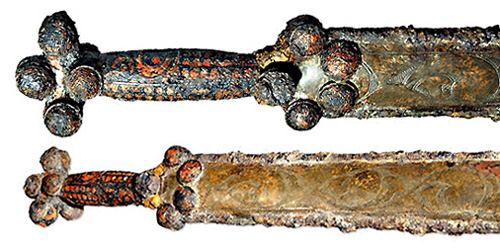
Kirkburn Sword found in Yorkshire. Pics from the British Museum
 Attachment: 74.03 KB Attachment: 74.03 KB
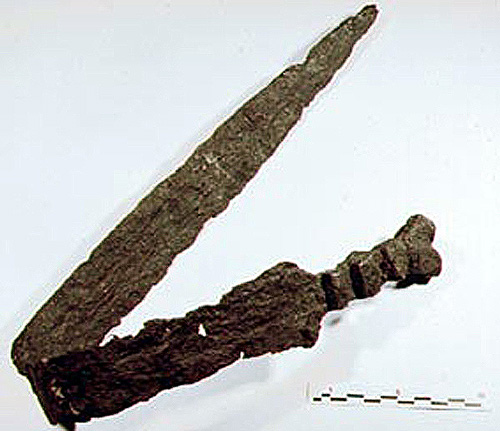
Celto-Iberian LaTene Sword
 Attachment: 90.9 KB Attachment: 90.9 KB
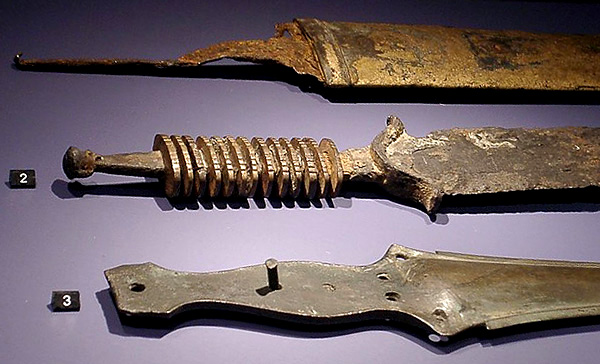
Composite Grip on LaTene Sword
Two swords
Lit in Eden’s flame
One of iron and one of ink
To place within a bloody hand
One of God or one of man
Our souls to one of
Two eternities
|
|
  |
 |
|
Nathan Bell
|
 Posted: Sat 08 May, 2004 10:01 pm Post subject: Re: Metal Hilts Posted: Sat 08 May, 2004 10:01 pm Post subject: Re: Metal Hilts |
 |
|
| Kirk Lee Spencer wrote: | I can not think of any LaTene swords from Ireland or Britain with metal hilts other than the anthropoid stuff. Not too many such continental finds either... that I know of.
The most famous is the Kirkburn sword. (I don't like the sword that much but it has a nice name.)
I have also seen a Celto-Iberian sword that seems to have some kind of metal plates attached to the hilt.
And there is one other with circular spacers much like the one posted earlier on this thread.
ks |
And as you'll notice, even these pieces originally had a good amount of organic material in the hilts. Even the Kirkburn originally had horn underneath the enameled grip piece and horn filling out the lobes of the pommel/guard areas. An issue of simply "more metallic components" rather than a metallic hilt.
I have seen (pictures) of a good number of Iberian swords with all metal and predominantly metal hilts, though. They also commonly have a form of doubled pommel, too, often two very spherical knobs.
I kind of like the Kirkburn, though, Kirk! The enamel work is a bit over the top, but I think the hilt shape is pretty nice, actually?
|
|
   |
 |
Kirk Lee Spencer

|
 Posted: Sun 09 May, 2004 6:29 am Post subject: More Metallic Hilts Posted: Sun 09 May, 2004 6:29 am Post subject: More Metallic Hilts |
 |
|
Hi Nathan...
You're right. These hilts were not all-metallic. I thought the Kirkburn (Yorkshire England--not a continental find as I said in earlier post) was all metal and glass... thanks for the info on the horn surrounding elements... I wonder what the pommel and guard profiles would have looked like. Who knows, with these elements I might like the looks--It would balance out the hilt a little more I think.
Here is a link ( http://www.ffil.uam.es/equus/warmas/tipolog/fig01.html ) to a slide show from a museum in Spain. I have taken you into the slide show at my favorite Horse-Head Falcata... The rest of the show is well worth seeing.
Are these swords similar to the Iberian LaTene swords you mentioned Nathan?
They seem to be hybrids between the older anntena sword/daggers and the later earliest Celtic stuff?
ks
 Attachment: 27.77 KB Attachment: 27.77 KB
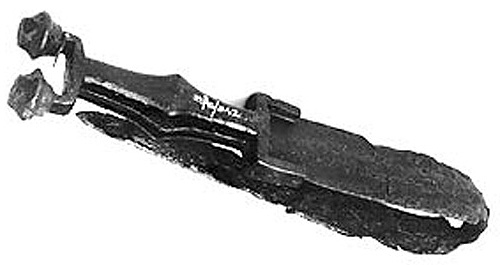
Celto-Iberian Anntena-like sword
 Attachment: 30.37 KB Attachment: 30.37 KB

Anntena-like Celto-Iberian Sword
 Attachment: 15.09 KB Attachment: 15.09 KB

Another Anntena-like Celto-Iberian
Two swords
Lit in Eden’s flame
One of iron and one of ink
To place within a bloody hand
One of God or one of man
Our souls to one of
Two eternities
|
|
  |
 |
|
Nathan Bell
|
 Posted: Sun 09 May, 2004 9:03 am Post subject: Re: More Metallic Hilts Posted: Sun 09 May, 2004 9:03 am Post subject: Re: More Metallic Hilts |
 |
|
| Kirk Lee Spencer wrote: | Hi Nathan...
You're right. These hilts were not all-metallic. I thought the Kirkburn (Yorkshire England--not a continental find as I said in earlier post) was all metal and glass... thanks for the info on the horn surrounding elements... I wonder what the pommel and guard profiles would have looked like. Who knows, with these elements I might like the looks--It would balance out the hilt a little more I think.
Here is a link ( http://www.ffil.uam.es/equus/warmas/tipolog/fig01.html ) to a slide show from a museum in Spain. I have taken you into the slide show at my favorite Horse-Head Falcata... The rest of the show is well worth seeing.
Are these swords similar to the Iberian LaTene swords you mentioned Nathan?
They seem to be hybrids between the older anntena sword/daggers and the later earliest Celtic stuff?
ks |
Yes, those are the types of swords I was rather inadequately describing!
It does indeed seem to me like the Iberians took the earlier Halstatt antennae dagger/short swords and went a different direction with them. Some that look very much like those you have posted, I have seen labeled with dates that would correspond with celtic eras as late as mid La Tene II. I suppose the Iberians enjoyed staying closer to the "old school" artistic styles?
I really like those little Iberian swords, too. Perhaps a nice custom project for down the road, or something for the Albion NextGen list 
|
|
   |
 |
Kirk Lee Spencer

|
 Posted: Mon 10 May, 2004 6:24 am Post subject: Posted: Mon 10 May, 2004 6:24 am Post subject: |
 |
|
Nathan...
Actually it was a great description... I had just not thought to check dates on those types of swords or considered that they were as close to the ball-like LaTene hilts as they were to the antenna types.
By the way, do you know if the enamel we see on celtic sword, shields etc, was similar to modern enamel paint... Have you read how they made and applied this material.
Thanks
ks
Two swords
Lit in Eden’s flame
One of iron and one of ink
To place within a bloody hand
One of God or one of man
Our souls to one of
Two eternities
|
|
  |
 |
|
Nathan Bell
|
 Posted: Tue 11 May, 2004 4:08 am Post subject: Celtic enamel Posted: Tue 11 May, 2004 4:08 am Post subject: Celtic enamel |
 |
|
| Kirk Lee Spencer wrote: | Nathan...
Actually it was a great description... I had just not thought to check dates on those types of swords or considered that they were as close to the ball-like LaTene hilts as they were to the antenna types.
By the way, do you know if the enamel we see on celtic sword, shields etc, was similar to modern enamel paint... Have you read how they made and applied this material.
Thanks
ks |
Hi Kirk,
I have read a brief article by Gunther Haseloff on celtic enamel. He says
| Quote: | The enamel used by the celts consists of quartz glass with a small quantity of added lead. The glassy mixture was turned red by adding cuprite, Cu 2 O. During the normal heating process, Cuprite is transformed to cupric oxide, CuO, murky green in colour; the cuprote therefore had to be processed further and the oxygen removed.It seems that in most cases the glass mass was heated jsut until it became soft and then pressed into the cavities of the metalwork after roughening the surfaces to ensure adhesion. The enamel workshops discovered at Bibracte (Mont-Beuvray) yielded a great many objects the enamel of which had clearly come away from the setting
Two techniques were used in eneamling. In the first, the enamel was poured in semiliquid form into the settings (email champleve) In the second the enamel was secured to the surface of the metal with rivets. |
The author also states that coral insets and enamel were used side by side: the Witham shield had coral insets, while the Battersea shield was enamel...
He also mentions the yellow enamel, stating that it is mostly found in Scotland. He doesn't say what chemical was added to the quartz to make yellow 
|
|
   |
 |
Kirk Lee Spencer

|
 Posted: Tue 11 May, 2004 6:21 am Post subject: Posted: Tue 11 May, 2004 6:21 am Post subject: |
 |
|
Thanks so much Nathan. That is exactly what I was looking for!
You are a great resource... I,m glad you're here.
ks
Two swords
Lit in Eden’s flame
One of iron and one of ink
To place within a bloody hand
One of God or one of man
Our souls to one of
Two eternities
|
|
  |
 |
Kirk Lee Spencer

|
 Posted: Sat 15 May, 2004 10:07 pm Post subject: Irish LaTene Posted: Sat 15 May, 2004 10:07 pm Post subject: Irish LaTene |
 |
|
| David McElrea wrote: | Hi Nathan,
I just wanted to thank you for your great responses. I'll keep an eye out for the articles-- couldn't find them anywhere online (to buy). I suppose I may just not know where to look. Anyway, thanks again.
Yours,
David |
David...
I thought I would post my favorite Rynne article:
"Some Early Iron Age Sword Hilts from Ireland and Scotland"
Even if you have seen it, I think it would go well with this thread.
ks
 Attachment: 99.46 KB Attachment: 99.46 KB
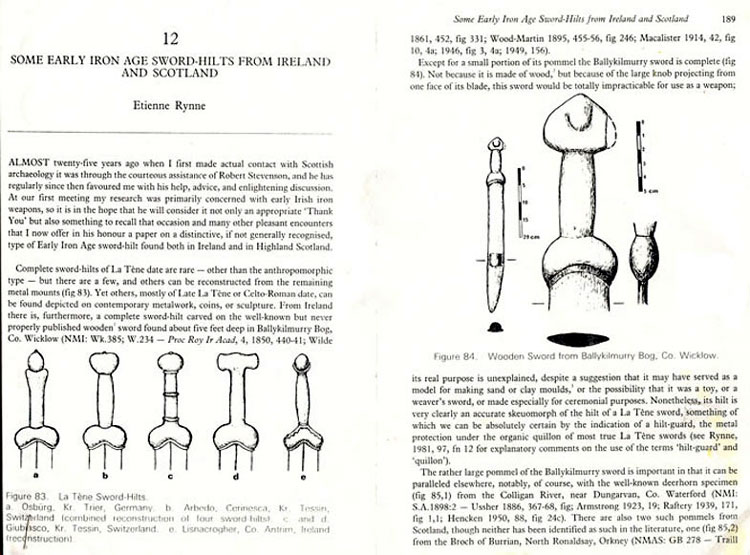
"Iron Age Sword Hilts of Ireland and Scotland" by Etienne Rynne
 Attachment: 65.27 KB Attachment: 65.27 KB
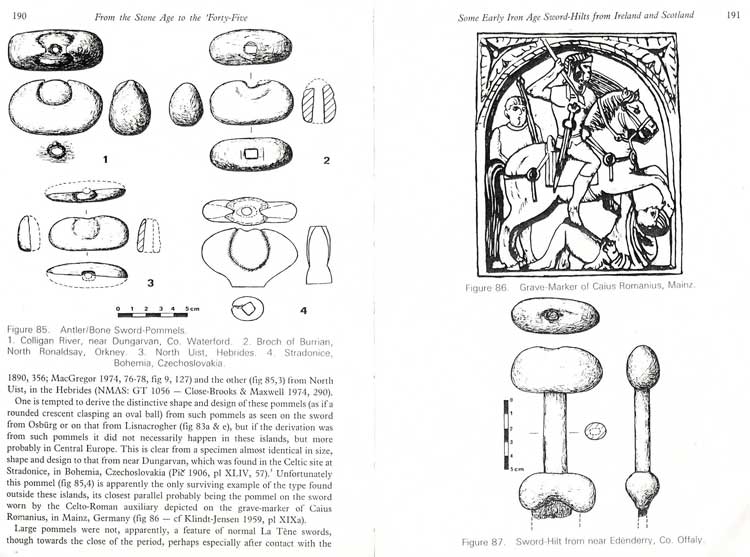
"Iron Age Sword Hilts of Ireland and Scotland" by Etienne Rynne
 Attachment: 74.71 KB Attachment: 74.71 KB
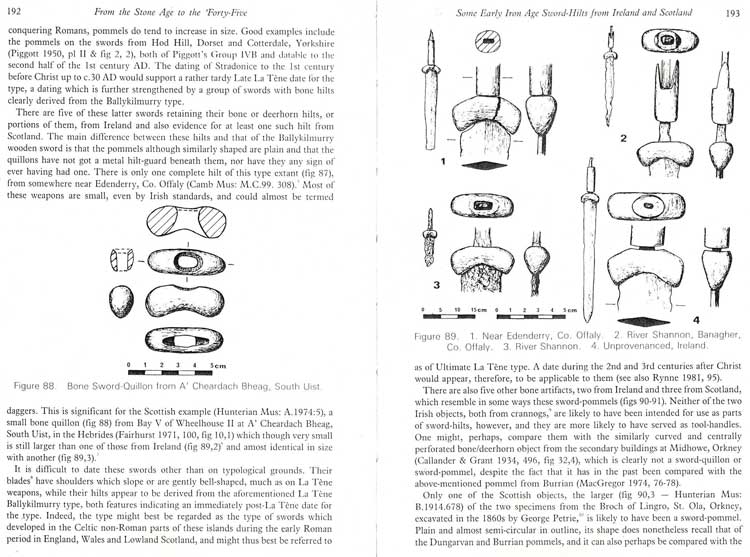
"Iron Age Sword Hilts of Ireland and Scotland" by Etienne Rynne
Two swords
Lit in Eden’s flame
One of iron and one of ink
To place within a bloody hand
One of God or one of man
Our souls to one of
Two eternities
|
|
  |
 |
Kirk Lee Spencer

|
 Posted: Sat 15 May, 2004 10:13 pm Post subject: Posted: Sat 15 May, 2004 10:13 pm Post subject: |
 |
|
Here is the last page...
ks
 Attachment: 70.93 KB Attachment: 70.93 KB
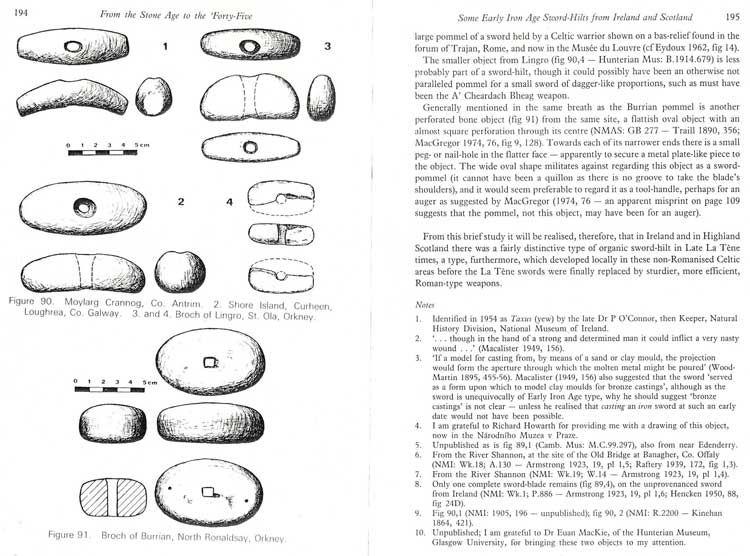
"Iron Age Sword Hilts of Ireland and Scotland" by Etienne Rynne
Two swords
Lit in Eden’s flame
One of iron and one of ink
To place within a bloody hand
One of God or one of man
Our souls to one of
Two eternities
|
|
  |
 |
David McElrea

|
 Posted: Wed 19 May, 2004 12:47 pm Post subject: Posted: Wed 19 May, 2004 12:47 pm Post subject: |
 |
|
Hi Kirk,
Thanks very much for posting Rynne's article-- In fact I hadn't yet seen it. Sorry for the delayed response, as well. I'm in Norway (on my brother-in-laws computer) and haven't been online for a few days (two hundred and something posts since Iast signed in to myArmoury!).
Either way, fantastically helpful. Thanks again,
David
|
|
  |
 |
John Gage
Industry Professional

Location: New Glarus, WI Joined: 01 Mar 2004
Posts: 154
|
 Posted: Wed 26 May, 2004 6:32 pm Post subject: Custom damascus celtic leaf blade dagger Posted: Wed 26 May, 2004 6:32 pm Post subject: Custom damascus celtic leaf blade dagger |
 |
|
Great thread guys. I was so inspired by it i got to working on a custom celtic leaf blade. I had ordered some pattern weld billets and thought i would use one for this project. I have just finished forging the blade and an initial grind. I am still pondering the exact hilt and pommel design. The hilt will be of wood and bronze. I am considering mahogany, maple burl, walnut burl , Padouk or zebrawood. I am also cosidering fullers. Here are some pics of where im at. The billet, blade and possible hilt design.
11" Blade
17" overall
|
|
   |
 |
Kirk Lee Spencer

|
 Posted: Sun 06 Jun, 2004 6:01 pm Post subject: Posted: Sun 06 Jun, 2004 6:01 pm Post subject: |
 |
|
Hi John...
I have been out of my office for awhile so I did not see that there had been a response to this thread...
Looks like you have a great start there. I think I would use the mahogany. For some reason exotic or fancy burl woods just don't look right to me on these ancient swords (maybe I have seen too many art knives at the shows). Also a more simple wood in the hilt would not distract from the beautiful shape of the blade and the damascus patterns...
Be sure and post a picture when you are done.
Many of the early iron age swords had an anthropomophic hilt. I think that it looks good on smaller swords.
Most of these hilts are of solid bronze... like the urnfield bronze hilt you posted), yet the the upper and lower parts of the hilt are stretched out to look like arms and legs.
I think that many of the earliest iron swords with organic components to the hilt also had a more anthropomorphic look.
I found an archeological report where the researchers excavated around the carbonized remains of the hilt and then took a plaster cast of it. This gives a rare glimpse into what the geometry of one of these organic hilts may have looked like.
The image in the far right is all that would normally be found of such a hilt. The next picture to the right is the two pasts of the plaster casting. finally to the far right is a replica made from the shadowy information gained from the carbonized remains.
ks
 Attachment: 79.93 KB Attachment: 79.93 KB
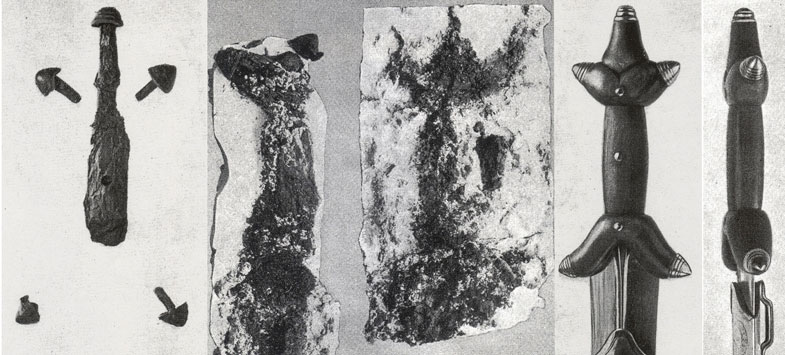
Carbonized LaTene Hilt with Reconstruction
Two swords
Lit in Eden’s flame
One of iron and one of ink
To place within a bloody hand
One of God or one of man
Our souls to one of
Two eternities
|
|
  |
 |
|
Nathan Bell
|
 Posted: Wed 09 Jun, 2004 4:27 am Post subject: Posted: Wed 09 Jun, 2004 4:27 am Post subject: |
 |
|
| Kirk Lee Spencer wrote: | Hi John...
I think that many of the earliest iron swords with organic components to the hilt also had a more anthropomorphic look.
ks |
I would agree. I didn't use to care for the Liebau sword, but it's really grown on me. Interesting how it combines forms to look both phallic and anthropomorphic at the same time!
I believe a good many of the organic La Tene I and II swords are aiming to achieve a stylized anthropomorphic look, from what fittings are sometimes left....seems you can also see the development of these trilobate "anthro" pommels into the later period (and often Romanized) styles like the "pregnant egg" styles seen in Ireland and North Scotland.
Thanks for the photos and such, it really helps illustrate this discussion (I don't have a scanner, myself  ) )
|
|
   |
 |
John Gage
Industry Professional

Location: New Glarus, WI Joined: 01 Mar 2004
Posts: 154
|
 Posted: Wed 09 Jun, 2004 5:09 pm Post subject: Posted: Wed 09 Jun, 2004 5:09 pm Post subject: |
 |
|
Hi Kirk,
I agree mahogany for the hilt would be the best choice. I like the hilt you have posted i just might use something like that design. I will post a few pics when im finished and would like to get your thoughts on it. Ive just setup my lathe and should have a gas forge built very shortly. Woohoo! I am so done with coal. This forum is an excellent place for a new artisan to get ideas and thoughts from very knowlegeable people.
Regards,
John
.
|
|
   |
 |
Kirk Lee Spencer

|
 Posted: Mon 14 Jun, 2004 8:24 pm Post subject: From Proto-Celtic to Romano-Celtic Posted: Mon 14 Jun, 2004 8:24 pm Post subject: From Proto-Celtic to Romano-Celtic |
 |
|
| Nathan Bell wrote: | | Kirk Lee Spencer wrote: | Hi John...
I think that many of the earliest iron swords with organic components to the hilt also had a more anthropomorphic look.
ks |
I would agree. I didn't use to care for the Liebau sword, but it's really grown on me. Interesting how it combines forms to look both phallic and anthropomorphic at the same time!
I believe a good many of the organic La Tene I and II swords are aiming to achieve a stylized anthropomorphic look, from what fittings are sometimes left....seems you can also see the development of these trilobate "anthro" pommels into the later period (and often Romanized) styles like the "pregnant egg" styles seen in Ireland and North Scotland.
|
Hi Nathan…
Great insight there... I also enjoy speculating on how these swords have developed through time.
As a matter of fact it is tracing this type of organic growth in sword design that has intrigued me for the last year or so… sort of a research project of mine… to trace the development of the sword through what I call “design space.” Since we very rarely have perfect knowledge of a swords exact date or geographic distribution, I would like to put aside strict chronological considerations and all geographic restrictions (for this project at least) and just take the swords as we find them in museums, private collections and archeological reports.
From this collection of swords, I want to select a series of individual swords that would reflect a somewhat hypothetical organic type of growth or evolution from early Bronze Age daggers to the hangers of the 19th century.
The end product would be to overlay each of these swords in order and create a video of sorts showing one possible trajectory of the growth of the sword in “design space.”
Just as a historian may recognize a beautiful archetypical sword that captures the ideal characteristics of a period sword, this would be a sort of archetypical progression of swords.
I have divided the task into five divisions:
1. Bronze Age
2. Celtic Swords
3. Migration/Viking Swords
4. Knightly Swords
5. Complex Hilts
For this post, I have quickly put together my current series for Celtic Swords…
To get the full effect you should move your eyes from sword to sword, like you were reading words, from left to right, top to bottom. “Read” through once concentrating on the pommel. Then do it again concentrating on the grip. And one more time focusing on the lower guard. I hope that you will be able to see what I am talking about… seeing a sword “grow” in design space.
ks
 Attachment: 89.45 KB Attachment: 89.45 KB
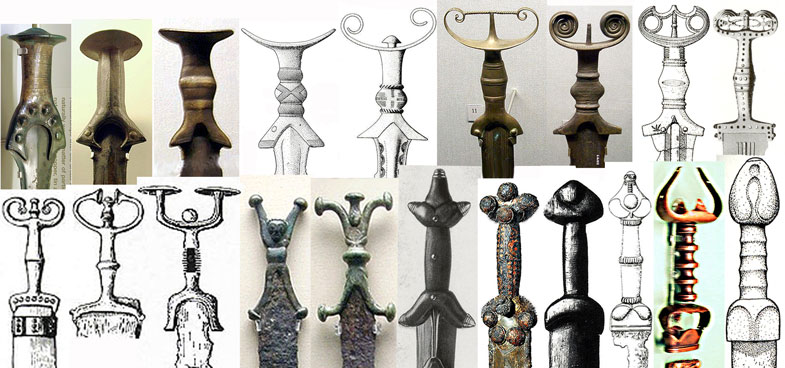
Celtic Sword Growth from Bronze Age (upper row) through Iron Age (lower row)
Two swords
Lit in Eden’s flame
One of iron and one of ink
To place within a bloody hand
One of God or one of man
Our souls to one of
Two eternities
|
|
  |
 |
|
James King
|
 Posted: Mon 14 Jun, 2004 9:56 pm Post subject: hilt development Posted: Mon 14 Jun, 2004 9:56 pm Post subject: hilt development |
 |
|
|
OUTSTANDING Kirk! I believe this is one of the most informative threads I have read.I am glad to see (finally) some one illustrating the developmental similarities in "Celtic" and "Roman" swords.I have always had a problem with the commonly accepted view of Iron age sword hilts being purely "Celtic" or purely "Roman".When discussing later period European swords...MIgration, "viking", medieval, etc. there are rarely what one could call "ethnic specific" swords.Some sword/hilt types or decoration can be assigned to different areas ,the Norwegian longsax for example,but as a general rule swords and their fittings were same all over NW Europe after circa 500 A.D.How can 2 culture's ,(Celtic and Roman) fight, trade, etc for 500 years and not influence each other dramaticly.The classic image of the Wild celt with his typical LaTene long sword and the Roman legionare with his pompei/mainz gladius probably never existed at the same time.Sure the Gauls (not nec. the Brits) used longer swords in the First century b.c., but the Roman swords of that period used longer swords as well,( I believe Blades from this period reached upwards of 28").I am sure the hilt designs were'nt all that different.When the Romans had adopted the shorter swords(???)The Gauls were still using the "celtic" longsword...the spatha, in the service of Rome.Another question,why do we have no trouble accepting that it was common for "Germanic" warriors of a slightly later period to use Roman swords(bogg finds), but "Celts"of the LaTene did not?Your work shows a simple , clear , line of development of {European} swords of the period.
|
|
  |
 |
|
Nathan Bell
|
 Posted: Tue 15 Jun, 2004 1:52 pm Post subject: Re: hilt development Posted: Tue 15 Jun, 2004 1:52 pm Post subject: Re: hilt development |
 |
|
| James King wrote: | | I have a problem with the commonly accepted view of Iron age sword hilts being purely "Celtic" or purely "Roman" I am sure the hilt designs were'nt all that different. |
Hi James,
Well, I must both agree and disagree.
If it were simply a matter of utility and basic aesthetics, perhaps the evidence would show "Roman" styles far back into Halstatt and La Tene I.
BUT, I think that there is a longstanding, talismanic significance to the Celtic hilt forms that was actually remarkably resistant to change, which can also be seen in the lineup above (not actually a direct timeline)
You do see a trending toward what we think of as a Roman hilt design in the later La Tene---large ovate pommel and straight shouldered guard. Also true that we have the Celts wielding both shorter and longer swords, and newer evidence shows that the Romans were using some fairly long swords in the Republican period...
However, the hilt design of the Celtic sword has a very, very strong connection to a stylized human-like form, sometimes more overt, other times less so. The timeline above illustrates this better than anything else! You have a period of over a thousand years where the Celtic sword shows a very strong tendency toward a stylized human form with either trilobate or bilobate pommel for 800 years or so----the hilt maintaining this symbolism even as the blade shape, style and length changes rather dramatically.
Only in the very later stages are we seeing a globular pommel, and even then, as in the Thorpe, Worton, and Caerlon swords, the stylized bilobate /trilobate symbolism is carried onto and carved into the "Roman" pommel and guard forms. If it were simply a matter of aethetics or practicality, I could see a more even adoption of the less stylized pommel forms. Yet, when we see this appear, as in the Cotterdale and Hod Hill swords, it is in the final stages of La Tene, a time when Roma is actively annihilating the cultural and religious trappings of "Celtic" society (i.e., the destruction of the druid college at Anglesey, etc.....)
The stylized form of the Celtic sword carries across the vast majority of the Halstatt and L:a tene timelines and across countries and geographic boundaries. Even in the last gasps of La Tene, during the Empire's height, we see the Celts doggedly holding onto the bilobate and trilobate forms for their swords. Given the very high incidence of stylized human forms recurring throughout Halstat and La Tene and cutting across boundaries in the material culture, from harness trappings to fibulae and pendants to carvings on frescoes....I seriously doubt that the anthropomorphic hilt symbolism would be lightly dropped or amalgamated into a cultural blending of styles.
Looking at the above photos, one can see the opposite, and the double lobed and triple-lobed motif cotinues virtually to the end of La Tene.
In short, when I see portrayals of Celts with Hod Hill style hiltwork, in a middle La Tene setting, I find this to be perhaps a misintepretation of the evidence and a misunderstanding of what the Celts were doing with those bilobate styles. So I think that when Osprey gives a Gallic warrior in Hannibal's service a Hod Hill sword, I think they are going off-base with their suppositions.
|
|
   |
 |
|
James King
|
 Posted: Tue 15 Jun, 2004 4:23 pm Post subject: Posted: Tue 15 Jun, 2004 4:23 pm Post subject: |
 |
|
|
Exellent post Nate. I stand corrected .After rereading my post I believe I was a bit unclear.I agree totaly that "Roman" style hilts like the one from Hod Hill,Cotterdale, etc. are later LaTene IV, and may have been Roman manufactured.I believe (and should have made more clear)that many earlier Roman Hilts Looked more "celtic" i.e. sloped shoulders on many Republican blades,and Sculptural depictions(looking for sources)of trilobate pomels on Roman swords.IMHO early republican blades may have been more similar to LeTene I blades, than is often illustrated(one exeption is very small illustration in Connolly's Greece and Rome at war p.134 that shows a Roman surveyor armed with a sword with a Latene hilt).When did the "Roman" type hilt with spheroid pommel ,fluted grip,and straight guard develope?200b.c.?100b.c.?50b.c.?It appears that the "Roman" type hilt of the Later Republic/early empire is merely a simplified LaTene type hilt....what else could it have developed from?
|
|
  |
 |
|
Nathan Bell
|
 Posted: Tue 15 Jun, 2004 5:34 pm Post subject: Posted: Tue 15 Jun, 2004 5:34 pm Post subject: |
 |
|
| James King wrote: | | Exellent post Nate. I stand corrected .After rereading my post I believe I was a bit unclear.I agree totaly that "Roman" style hilts like the one from Hod Hill,Cotterdale, etc. are later LaTene IV, and may have been Roman manufactured.I believe (and should have made more clear)that many earlier Roman Hilts Looked more "celtic" i.e. sloped shoulders on many Republican blades,and Sculptural depictions(looking for sources)of trilobate pomels on Roman swords.IMHO early republican blades may have been more similar to LeTene I blades, than is often illustrated(one exeption is very small illustration in Connolly's Greece and Rome at war p.134 that shows a Roman surveyor armed with a sword with a Latene hilt).When did the "Roman" type hilt with spheroid pommel ,fluted grip,and straight guard develope?200b.c.?100b.c.?50b.c.?It appears that the "Roman" type hilt of the Later Republic/early empire is merely a simplified LaTene type hilt....what else could it have developed from? |
No, I stand corrected! I don't so much mind seeing Roman hilts displaying adopted or adapted features, as it's pretty clear that Romans adopted items either wholesale or slightly modified. I myself hilted my hispaniensus blade with a sloped shoulder "celtic" style guard with Isle of Delos style pommel. I also discussed the idea with Hugh Fuller just this weekend, the adoption of the trilobate pommel---adopted in all liklihood because of the separate and distinct "fica" symbol to the Roman mind. I just revolt at the idea of supplying Celtic swords with austere pommels stripped of the fairly obvious symbolic value!
A very interesting question of when the spheroid-based hilt styles came into being. I simply have no answer for this! Republican hilts seem to have much more variety, as Matt Amt showed with his Ahenobarbous (sp) hilt and Hugh's "fica" hilt... yes I don't see why Romans may not have directly used some of the "Celtic" styles, but with less reverence to the symbolism....
|
|
   |
 |
|
|
You cannot post new topics in this forum
You cannot reply to topics in this forum
You cannot edit your posts in this forum
You cannot delete your posts in this forum
You cannot vote in polls in this forum
You cannot attach files in this forum
You can download files in this forum
|
All contents © Copyright 2003-2024 myArmoury.com — All rights reserved
Discussion forums powered by phpBB © The phpBB Group
Switch to the Basic Low-bandwidth Version of the forum
|

